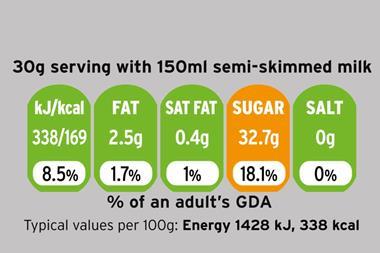Retailers will have to increasingly juggle the health requirements of their customers, government, consumer groups and health professionals to address the issues of obesity, child nutrition and the ageing population they serve.
The last decade has seen myriad initiatives to address fat, salt, sugar and calorific consumption, which, together with improved labelling, nutritional information and signposting, have helped consumers make more informed choices. But these moves have largely been reactive attempts to solve ‘problems’. Will they serve a more informed and complex customer base for whom ‘one size’ nutrition no longer works?
“The opportunity to grow a value-added market could be lost”
Consumers are increasingly identifying and understanding their own specialist dietary needs. The industry has gone part of the way in identifying and catering for ‘avoiders’, with free-from sections, range extensions such as Warburtons’ gluten-free offering and specialist brands such as Alpro for non-dairy, but it is still playing catch-up with a market that is rapidly developing and dominated by well-informed, high-value consumers.
It is time to rethink the approach to this market and embrace customers who understand the role of food and nutrition in their lives. If their requirements are not catered for by mainstream grocery retailers, they will buy the products elsewhere and the chance to grow a value-added market could be lost.
Just look at the sports-related protein market, which is expected to grow more than 100% to £350m in the next three years, driven chiefly by consumers who have gone online or to specialists to find the products they need. This is not the only sector to see rapid growth outside the supermarkets. Diet Chef, which delivers calorie-counted meals straight to consumers’ homes, now has 100,000 customers and Wiltshire Farm Foods has developed frozen meals for an ageing population, again delivered direct.
The world’s largest health and wellbeing show, in Anaheim, California, this month showcased a raft of new products and ranges targeting consumer needs. The products on display at Food & Drink Expo in Birmingham next week will also reflect consumers’ changing nutritional requirements.
As the wellness trends gather pace with new segments emerging such as the ‘young forever’ or the ‘weekend warriors’, how are these new market opportunities being addressed by retailers? The decision by Tesco to roll out NutriCentre and integrate an edited range within aisles reflects an understanding that consumer requirements are becoming more focused. More importantly, it has realised these products are forming a regular part of the weekly shop and are an important loyalty driver.
But this is a complex and fragmented market not easily understood by traditional category management; it requires a more detailed approach and knowledge. For retailers to win in this area, it is key that the underlying trends are quickly identified and key insights are turned into coherent offerings that have the credibility to win over these informed consumers.
Steven Esom is chairman of Product Chain Ltd















No comments yet